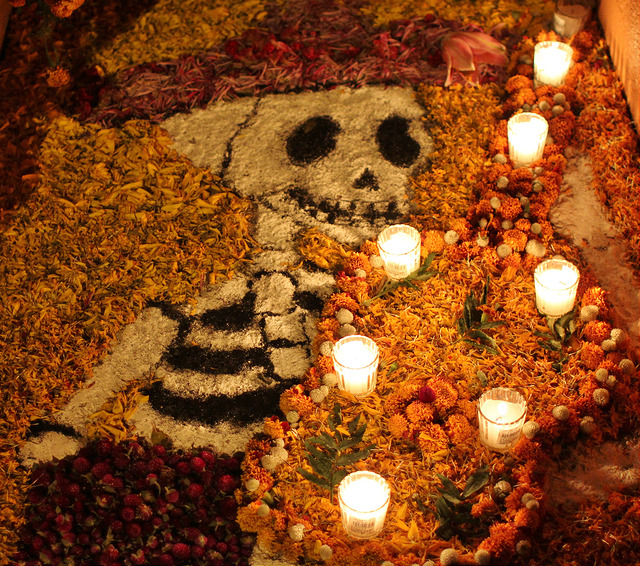[Editor’s note: This piece by Alexander Hanrath, originally published in 2016, gives an overview to the cultural importance of the Day of the Dead in Mexico, and offers some tips of how to enjoy the festivities in Oaxaca]
Nowhere in the world do the dead receive such a warm welcome back as in Mexico. The Day of the Dead (October 31st to November 2nd) is not a sombre or mournful occasion; on the contrary, it marks an opportunity for the dead to taste the pleasures of the living world, thanks to the efforts of their descendants. It is not just the pleasure but also the duty of the family to welcome its deceased, make a place for them, beckon them into the house, and offer them all the earthly pleasures they enjoyed when they were living, be that mezcal or mole.
The scenes in the cemeteries are magical. Vivid orange and yellow cempasúchiles (marigolds) decorate the tombstones and crosses, illuminated at night by the incandescent glow of thousands of small candles, made mystic by the blue smoke and the scent of burning copal. More than just decoration, both the cempasúchiles and the copal serve to guide the dead to the realm of the living and back again. Entire families, dressed in their Sunday best, crowd around their family tombs, bringing offers of food, alcohol, snacks, photos, and books. Music and dancing figure highly in the cemetery festivities, and people have been known to bring a band of mariachis to the grave.
The Day of the Dead is a blend of cultural traditions: the pre-Hispanic cult of death, the veneration of ancestors practiced both by the indigenous people and by Spanish pre-Christian pagans, and the commemoration of Catholic Saints on All Saints’ Day. Above all, it is a wholly Mexican occasion. The most ostentatious Christian festivity of the year—more exuberant than either Easter or Christmas—it illustrates the special relationship that Mexico has with death, a laughing, mocking familiarity embodied in the portrayal of grinning paper mache skeletons performing life’s everyday tasks. Dancing on someone’s grave, an action which carries negative connotation in the rest of the Christian world, here represents a reaching out of the living to the dead, a reunion in the most festive spirit.
At heart, the dia de muertos is a family affair, and therefore much of the ceremony takes place indoors, within the privacy of the family circle. This is the authentic Mexican day of the dead, a sight few foreigners see. On October 31st, the family builds the ofrenda (offering altar) together. There are many ways a family can build their ofrenda, but typically it will consist of an arch made of reed or corn husks, placed on a table with tablecloth, and decorated with flowers, fruit, bread, tins filled with sugar, and decorative tissues or paper. Figures of patron saints, candles, and pictures of the deceased occupy the centre of the altar. And then there are the earthly pleasures. Rich helpings of food are set out in the ofrenda for the arrival of the guests- i.e. the dead. They arrive in order of sacredness. The first to arrive are the souls of dead children, the angelitos, on November 1st around noon. The adults visit at the end of the afternoon on November 2nd. Glasses of water are left on the altar, as a refreshment after their long journey.
In some parts of Mexico, tables are set for the entire family, including empty chairs for the ancestors. In their brief return to the realm of the living, the dead eat and drink whatever they like: adults are offered their favourite food, as well as cigarettes and mezcal to their liking; candy, soda or even junk food will be bought for the angelitos. The dead, who are not seen but rather felt, do not eat the food but consume its essence, leaving behind positive energy. After the feast, the food from the altar is generously shared among the relatives, neighbours and friends.
The best way to get an overview of the varied celebrations around Oaxaca is to spread around your sightseeing. See the tianguis beforehand if you can. Find out when various celebrations are taking place, and visit cemeteries and processions of different communities. The Panteon General (Nov 2nd) and San Felipe cemeteries of Oaxaca are impressive sights, as are the processions on the night of November 1st. While people are generally friendly and open to the presence of tourists, it is easy to forget that you are intruding on an important family reunion. Don’t be afraid to take pictures, but keep your distance when doing so. With the right amount of respect and courtesy, you will gain a real insight into a beautiful tradition and a very Mexican celebration. Halloween will never be the same again.
Another tradition that has been kept alive in Oaxaca is the village or neighbourhood comparsa (procession). In the Oaxaca barrios of Trinidad de las Huertas and Jalatlco, and the village of Etla, masked dancers go from house to house, chanting, dancing to music and performing pantomime acts, all intended to help the dead go back to their realm, where some apparently are reluctant to return. The processions take place most of the night of November 1st through to the morning of November 2nd, lasting up to 12 hours or more. Programmes are distributed in advance on order to help visitors locate the processions’ whereabouts.
Finally, another Oaxacan attraction, the tapetes de arena—elaborately decorated rugs made of sawdust, coloured sand and glittery powder—is on display in the patio of Oaxaca Cathedral. These elaborately decorated works are usually used in burial ceremonies and specially exhibited in Oaxaca City for Dia de Muertos.








![Five Questions for John Benjamin [Image courtesy of C.O.S.]](https://www.oaxacatimes.com/wp-content/uploads/2018/07/unnamed-100x70.jpg)
